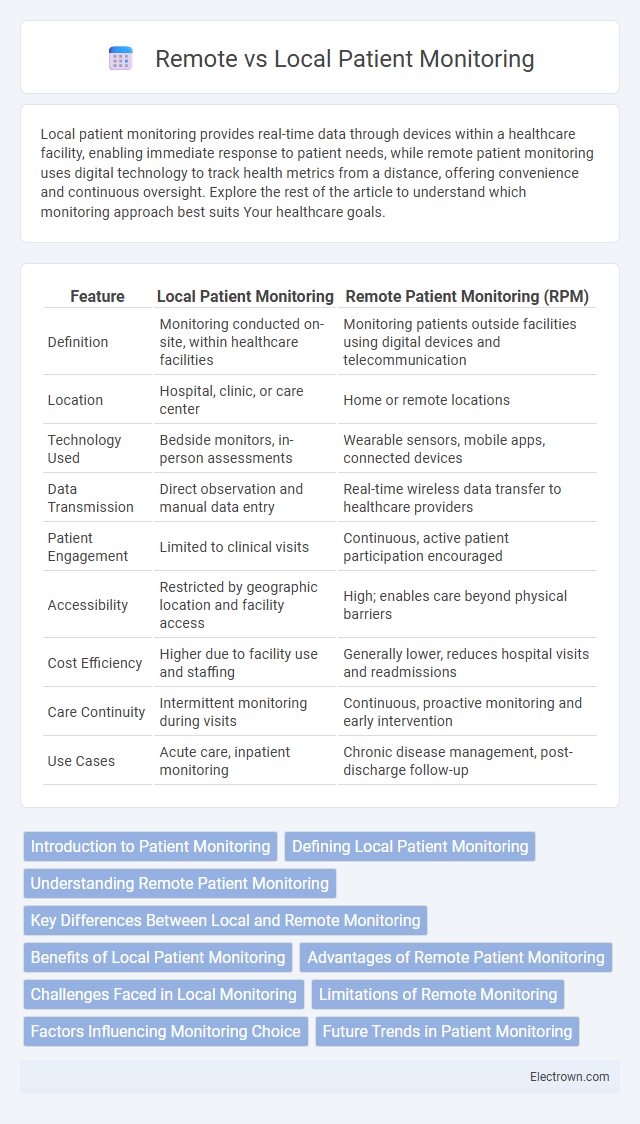Local patient monitoring provides real-time data through devices within a healthcare facility, enabling immediate response to patient needs, while remote patient monitoring uses digital technology to track health metrics from a distance, offering convenience and continuous oversight. Explore the rest of the article to understand which monitoring approach best suits Your healthcare goals.
Table of Comparison
| Feature | Local Patient Monitoring | Remote Patient Monitoring (RPM) |
|---|---|---|
| Definition | Monitoring conducted on-site, within healthcare facilities | Monitoring patients outside facilities using digital devices and telecommunication |
| Location | Hospital, clinic, or care center | Home or remote locations |
| Technology Used | Bedside monitors, in-person assessments | Wearable sensors, mobile apps, connected devices |
| Data Transmission | Direct observation and manual data entry | Real-time wireless data transfer to healthcare providers |
| Patient Engagement | Limited to clinical visits | Continuous, active patient participation encouraged |
| Accessibility | Restricted by geographic location and facility access | High; enables care beyond physical barriers |
| Cost Efficiency | Higher due to facility use and staffing | Generally lower, reduces hospital visits and readmissions |
| Care Continuity | Intermittent monitoring during visits | Continuous, proactive monitoring and early intervention |
| Use Cases | Acute care, inpatient monitoring | Chronic disease management, post-discharge follow-up |
Introduction to Patient Monitoring
Patient monitoring involves continuously tracking vital signs and health metrics to manage patient conditions effectively. Local patient monitoring uses on-site devices for real-time data collection within hospitals or homes, ensuring immediate response to critical changes. Remote patient monitoring leverages telehealth technologies to gather and analyze health information from a distance, empowering you to manage chronic diseases and improve care coordination outside traditional clinical settings.
Defining Local Patient Monitoring
Local patient monitoring involves the continuous observation of a patient's health status within a healthcare facility using on-site medical devices and direct clinical supervision. This method allows immediate data collection and rapid response to any changes in vital signs or symptoms by healthcare professionals. Your care benefits from real-time assessment and timely interventions in a controlled environment.
Understanding Remote Patient Monitoring
Remote Patient Monitoring (RPM) utilizes digital technologies to collect medical data from patients outside traditional healthcare settings, enabling continuous monitoring and timely interventions. RPM leverages devices such as wearable sensors and mobile apps to track vital signs, chronic conditions, and medication adherence, improving patient outcomes and reducing hospital readmissions. This approach contrasts with Local Patient Monitoring, which occurs within clinical environments, emphasizing the importance of real-time data transmission and remote healthcare provider access to patient information.
Key Differences Between Local and Remote Monitoring
Local patient monitoring involves real-time, on-site observation of vital signs and health status using devices directly connected to medical staff, ensuring immediate intervention. Remote patient monitoring (RPM) utilizes digital technologies like wearables and mobile apps to track patient data from a distance, enabling continuous health assessment outside clinical settings. Key differences include data transmission methods, with local monitoring relying on direct connections and RPM leveraging internet-based communication for broader accessibility and proactive care management.
Benefits of Local Patient Monitoring
Local patient monitoring offers the advantage of immediate access to real-time health data, enabling rapid response to changes in your condition. It reduces dependency on internet connectivity, ensuring continuous monitoring even in low-network areas. This proximity facilitates personalized care, improving accuracy and patient satisfaction through direct interaction with healthcare providers.
Advantages of Remote Patient Monitoring
Remote patient monitoring (RPM) enhances continuous healthcare delivery by enabling real-time data collection and analysis from patients outside clinical settings, improving chronic disease management and reducing hospital readmissions. RPM leverages advanced wearable devices and sensors that provide accurate, timely health insights, facilitating proactive interventions and personalized treatment plans. This technology reduces healthcare costs and increases access to care for patients in rural or underserved areas, ensuring consistent monitoring without the need for frequent in-person visits.
Challenges Faced in Local Monitoring
Local patient monitoring faces significant challenges such as limited access to real-time data due to reliance on manual measurements and in-person visits, leading to delayed response times in critical situations. High costs associated with dedicated medical staff and monitoring devices further strain healthcare facilities and reduce scalability. Additionally, inconsistent data quality and patient non-compliance during self-reporting hinder accurate diagnosis and timely intervention.
Limitations of Remote Monitoring
Remote patient monitoring often faces challenges such as inconsistent data transmission, limited connectivity in rural or underserved areas, and potential delays in critical health alerts due to technology failures. Privacy concerns and data security risks also limit the widespread adoption and trust in remote systems. Your healthcare outcomes may be compromised if remote monitoring devices malfunction or if patients have difficulty using the technology effectively.
Factors Influencing Monitoring Choice
Factors influencing the choice between local and remote patient monitoring include patient condition severity, technological infrastructure, and healthcare provider capabilities. Local monitoring is preferred for acute or complex cases requiring immediate clinical intervention, while remote monitoring suits chronic disease management and patients in rural or underserved areas. Cost considerations, data security, and patient preference also play critical roles in determining the optimal monitoring approach.
Future Trends in Patient Monitoring
Future trends in patient monitoring emphasize the integration of AI-driven analytics and wearable devices, enabling more accurate, real-time health data collection both locally and remotely. Advances in IoT technology facilitate seamless connectivity between patient sensors and healthcare providers, enhancing proactive care and early intervention. The shift toward personalized medicine leverages big data and machine learning algorithms to tailor treatments based on continuous monitoring outcomes.
Local vs Remote Patient Monitoring Infographic

 electrown.com
electrown.com